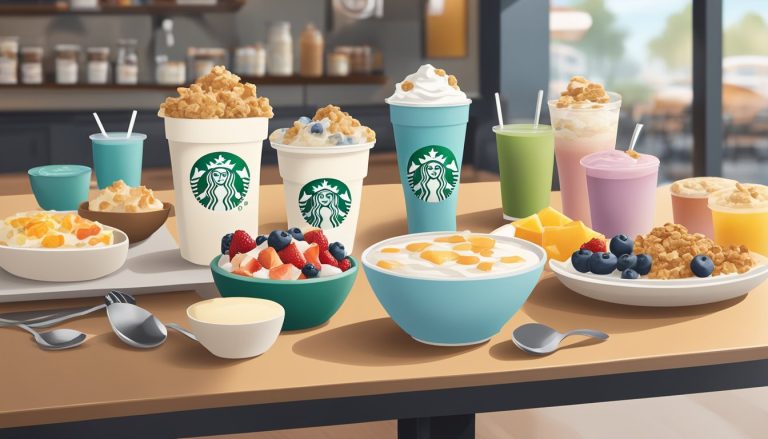Starbucks has become a morning ritual for millions, offering more than just coffee to fuel busy lives. The coffee giant has adapted to the fast-paced lifestyle of its customers by expanding its breakfast and grab-and-go options. From steel-cut oatmeal to protein-packed bistro boxes, Starbucks caters to health-conscious consumers seeking quick, nutritious meals.
Starbucks’ shift towards convenient food options reflects a broader cultural trend of on-the-go eating. This move aligns with changing consumer habits, where traditional sit-down breakfasts are often replaced by portable meals consumed during commutes or at desks. The company’s menu now features a variety of items designed for easy consumption, meeting the demands of time-strapped customers.
The evolution of Starbucks’ food offerings goes beyond mere convenience. It represents a strategic response to market demands and competitive pressures. By providing both beverages and food, Starbucks aims to capture a larger share of the breakfast market and increase customer loyalty. This approach not only boosts sales but also positions Starbucks as a one-stop shop for morning essentials.
The Rise of Grab-and-Go Breakfast
Grab-and-go breakfast has transformed morning routines and reshaped the food industry. This shift reflects changing lifestyles and consumer preferences for convenient, portable meals.
Cultural Shift Towards Convenience
The fast-paced modern lifestyle has fueled the popularity of grab-and-go breakfast options. Time-strapped consumers seek quick, portable meals that fit their busy schedules. This trend has led to an increase in pre-packaged breakfast items and on-the-go offerings at cafes and restaurants.
Starbucks has capitalized on this shift by expanding its breakfast menu. The coffee giant now offers a variety of grab-and-go options, including breakfast sandwiches, wraps, and protein boxes. These items cater to customers who prioritize convenience without sacrificing taste or nutrition.
The rise of remote work has further boosted the demand for grab-and-go breakfast. Many professionals now prefer quick, easy meals they can enjoy at home or take to their workspace.
The Impact on Food Industry Trends
The grab-and-go breakfast trend has significantly influenced food industry practices. Restaurants and cafes have adapted their menus and service models to accommodate this growing demand. Many establishments now offer dedicated grab-and-go sections or kiosks for quick service.
Food manufacturers have responded by developing new products designed for portability and convenience. These include single-serve portions, easy-to-open packaging, and foods that can be eaten without utensils.
The trend has also sparked innovation in food technology. Companies are investing in packaging solutions that maintain food freshness and quality for longer periods. This allows grab-and-go items to stay appealing and safe for consumption throughout the day.
Nutritional considerations have become increasingly important in grab-and-go offerings. Consumers now expect healthy, balanced options that provide sustained energy for their morning activities.
Starbucks’ Place in the Breakfast Landscape
Starbucks has become a major player in the breakfast market, transforming how many people start their day. The coffee giant’s breakfast offerings have evolved significantly, influencing consumer habits and reshaping coffee culture.
Evolution of Starbucks Breakfast Options
Starbucks began as a coffee shop but quickly expanded into breakfast territory. In the early days, their menu focused on pastries and baked goods. Over time, they introduced heartier options like breakfast sandwiches and wraps.
Today, Starbucks offers a diverse breakfast menu. It includes hot sandwiches, protein boxes, and sous vide egg bites. These cater to various dietary preferences and on-the-go lifestyles.
Starbucks has also embraced health trends. They’ve added items like oatmeal, yogurt parfaits, and fruit cups. This shift reflects changing consumer demands for nutritious breakfast options.
Starbucks’ Role in Shaping Consumer Habits
Starbucks has significantly influenced how people approach breakfast. They’ve made grab-and-go breakfast mainstream, aligning with busy lifestyles.
The company’s ubiquity has made it a daily stop for many commuters. This has created a new breakfast routine centered around coffee shops rather than home or diners.
Starbucks’ emphasis on customization extends to breakfast. Customers can modify their breakfast orders, promoting a personalized dining experience.
The chain has also popularized the concept of all-day breakfast. This flexibility caters to non-traditional work schedules and changing meal norms.
Nutritional Analysis of Starbucks’ Breakfast Offerings

Starbucks offers a range of breakfast items with varying nutritional profiles. Customers can find options to suit different dietary needs and health goals.
Understanding the Caloric and Nutritional Content
Starbucks’ breakfast menu includes items with diverse calorie counts. The Spinach, Feta & Egg White Wrap contains 290 calories, providing a balance of nutrients. It offers 20g of protein, which supports satiety. The wrap also contains 34g of carbohydrates, including 3g of fiber.
Some options, like the Impossible™ Breakfast Sandwich, have higher calorie counts but offer substantial protein. This plant-based choice caters to vegetarian customers seeking protein-rich options.
Baked goods often contain higher sugar content. Customers watching their sugar intake should review nutritional information carefully.
Healthier Choices and Customization Options
Starbucks provides several healthier breakfast alternatives. The Egg White & Roasted Red Pepper Egg Bites are a low-carb option rich in protein. For gluten-sensitive individuals, the Certified Gluten-Free Breakfast Sandwich offers a suitable choice with 18g of protein and only 2g of sugar.
Oatmeal serves as a fiber-rich breakfast option. Customers can customize it by choosing toppings to control sugar and calorie content.
Protein boxes offer balanced nutrition with combinations of fruit, cheese, and eggs. These boxes provide variety and portion control for those seeking a quick, nutritious meal.
Starbucks displays nutritional information, allowing customers to make informed choices based on their dietary requirements and health goals.
Exploring Starbucks’ Breakfast Menu

Starbucks offers a diverse breakfast menu catering to various tastes and dietary needs. The options range from classic favorites to innovative plant-based alternatives, providing customers with quick and satisfying morning meals.
Signature Breakfast Items and Seasonal Additions
Starbucks’ breakfast sandwiches are a popular choice for many customers. The double-smoked bacon, cheddar and egg sandwich combines savory flavors in a hearty package.
For those seeking lighter options, oatmeal and yogurt parfaits provide nutritious alternatives. These items can be customized with toppings like fresh fruit or nuts.
Pastries are a staple of the Starbucks breakfast menu. Croissants, muffins, and scones offer sweet and savory options for a quick bite.
Seasonal additions bring variety to the menu. These limited-time offerings often feature unique flavor combinations inspired by holidays or current food trends.
Plant-Based Alternatives at Starbucks
Starbucks has expanded its plant-based offerings to meet growing demand. The Impossible Breakfast Sandwich is a standout item, featuring a plant-based sausage patty.
Vegetarian options include the Spinach, Feta & Egg White Wrap. This protein-packed choice provides a satisfying meal without meat.
Plant-based milk alternatives are available for customizing beverages. Soy, almond, and oat milk can be used in coffee drinks or added to oatmeal.
Starbucks continues to innovate in this space, introducing new plant-based items to cater to changing dietary preferences. These options aim to provide flavor and nutrition without compromising on taste.
Beverages to Complement the Meal

Starbucks offers a wide range of beverages designed to pair perfectly with their breakfast items. From classic coffee and tea options to innovative seasonal drinks, there’s something to enhance every morning meal.
Coffee and Tea Selections
Starbucks’ signature Pike Place Roast provides a balanced flavor that complements most breakfast sandwiches. For a bolder start, the Caffè Americano offers a rich espresso taste. Those preferring a smoother option might choose a Cappuccino or Latte, which pair well with sweeter breakfast items.
Tea enthusiasts can select from various options. The English Breakfast tea blend offers a robust flavor that stands up to hearty breakfast sandwiches. For a lighter pairing, the Jade Citrus Mint green tea provides a refreshing contrast to savory meals.
Iced coffee and cold brew selections are popular for grab-and-go customers. These chilled options offer a crisp taste that pairs well with fruit-based breakfast items or yogurt parfaits.
Innovative and Seasonal Beverage Choices
Starbucks regularly introduces creative beverages to complement their breakfast menu. The Cinnamon Dolce Latte, with its sweet and spicy notes, pairs excellently with oatmeal or pastries.
Seasonal offerings like the Pumpkin Spice Latte in fall or the Peppermint Mocha in winter provide festive flavors to match limited-time breakfast items. These beverages often feature ingredients that echo the flavors of the season.
For those seeking a indulgent start to their day, Frappuccinos offer a dessert-like experience. The Caramel Frappuccino, for instance, can turn a simple breakfast into a treat.
Non-coffee drinkers can enjoy options like the Dragon Drink or Strawberry Açaí Refreshers. These fruity beverages provide a light and energizing complement to breakfast wraps or protein boxes.
Consumer Convenience and Accessibility
Starbucks has prioritized convenience and accessibility to cater to the fast-paced lifestyles of modern consumers. The company’s focus on efficient service and digital integration has revolutionized the way customers interact with the brand.
Mobile Ordering and Drive-Thru Services
Starbucks’ mobile app offers a seamless ordering experience. Customers can browse the menu, customize drinks, and pay in advance. This reduces wait times and allows for quick pickup at the counter or drive-thru.
The drive-thru service has become a cornerstone of Starbucks’ grab-and-go strategy. It caters to commuters and busy professionals seeking breakfast on the go. Many locations have optimized their drive-thru layouts to increase efficiency.
Starbucks has also implemented digital menu boards at drive-thrus. These displays can change based on time of day, weather, or popular items, enhancing the ordering process.
The Importance of Fast Service in Busy Lifestyles
Fast service is crucial for customers with tight schedules. Starbucks has streamlined its operations to minimize wait times without compromising quality.
The company has redesigned store layouts to create dedicated pickup areas for mobile orders. This reduces congestion and speeds up service for all customers.
Starbucks has also expanded its grab-and-go breakfast options. These items are strategically placed near registers for quick purchases. The menu includes protein boxes, sandwiches, and wraps that are easy to eat on the move.
Training programs focus on efficiency and multitasking. Baristas are equipped to handle complex orders quickly while maintaining accuracy and customer service standards.
Corporate Responsibility and Partnerships
Starbucks demonstrates a strong commitment to corporate responsibility and strategic partnerships. The company focuses on sustainability initiatives and collaborates with food and beverage brands to enhance its offerings and impact.
Sustainability Initiatives
Starbucks implements comprehensive sustainability programs throughout its supply chain. The company’s C.A.F.E. Practices initiative ensures ethical sourcing of coffee beans, supporting farmers and promoting environmentally friendly cultivation methods. Starbucks has set ambitious goals to reduce its environmental footprint, including a commitment to 50% reduction in carbon emissions, water usage, and waste by 2030.
The company has also introduced reusable cup programs and invested in recyclable packaging solutions. These efforts aim to minimize single-use plastic waste associated with the grab-and-go culture.
Collaboration with Food and Beverage Brands
Starbucks partners with various food and beverage brands to diversify its product range and cater to evolving consumer preferences. The collaboration with Nestlé has expanded Starbucks’ retail presence, bringing its coffee products to grocery stores and homes worldwide.
The company also works with local bakeries and food suppliers to offer region-specific menu items. These partnerships support small businesses and provide customers with fresh, locally-sourced options.
Starbucks continues to explore innovative collaborations, such as plant-based food partnerships, to meet growing demand for sustainable and health-conscious choices in its grab-and-go offerings.
Looking Ahead

The breakfast landscape is evolving rapidly, with changing consumer preferences and technological advancements driving innovation. Starbucks continues to adapt its offerings to meet these shifts in the grab-and-go culture.
Future Trends in Breakfast Consumption
Health-conscious options are gaining traction, with consumers seeking nutritious, portable meals. Plant-based alternatives are expected to grow in popularity, catering to vegetarian and vegan customers.
Customization will become increasingly important. Consumers want personalized breakfast options that cater to their dietary needs and taste preferences.
Global flavors are set to influence breakfast menus, introducing diverse ingredients and spices. This trend aligns with the growing interest in international cuisines.
Sustainability will play a crucial role in food packaging and sourcing. Eco-friendly materials and locally-sourced ingredients will become more prevalent.
Innovations on the Horizon at Starbucks
Starbucks is likely to expand its mobile ordering capabilities, potentially introducing AI-powered recommendations based on customer preferences and past orders.
The company may develop smart packaging solutions that keep food fresh longer and provide real-time nutritional information.
Starbucks could explore partnerships with local food artisans to offer unique, regional breakfast items in different markets.
Automated kiosks and grab-and-go lockers might be introduced in high-traffic areas to reduce wait times and enhance convenience.
The coffee giant may invest in research to create functional breakfast foods, incorporating ingredients that boost energy or support immune health.




